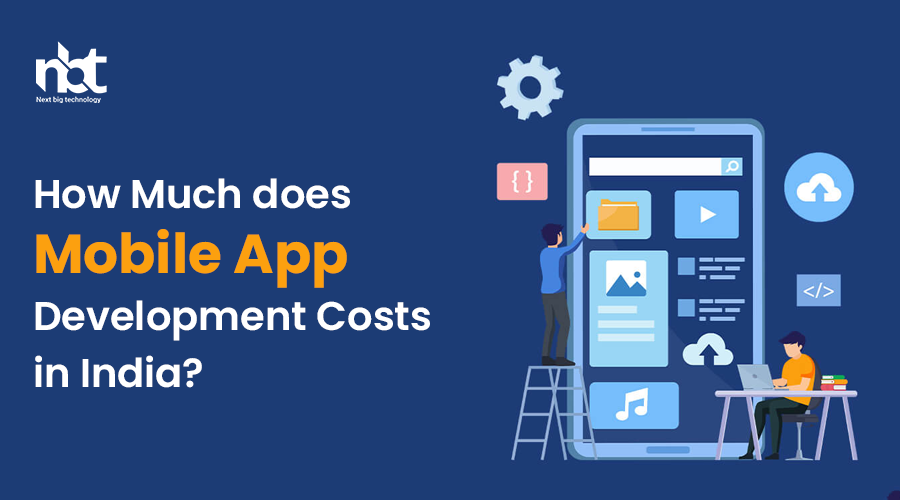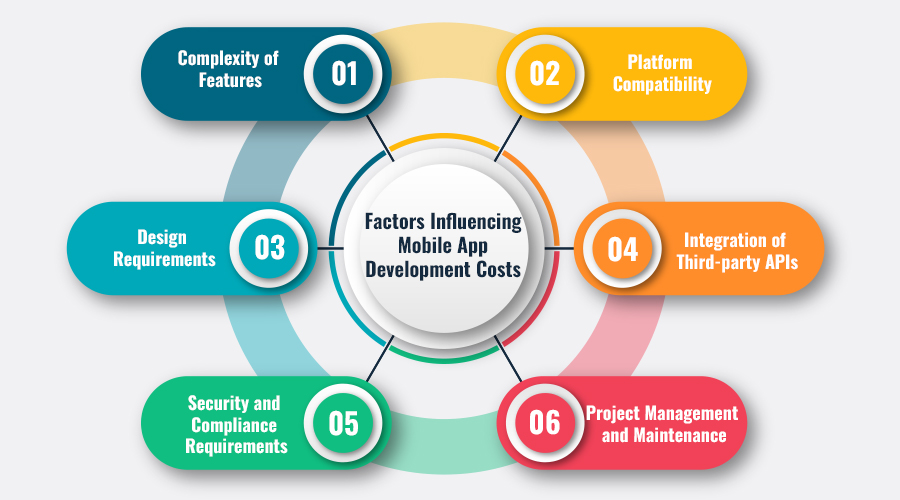Table of Contents
Overview of Mobile App Development Costs
In today’s digital era, mobile applications have become an essential tool for businesses to connect with their customers, streamline operations, and stay competitive in the market. However, one of the primary concerns for businesses embarking on the journey of mobile app development is the cost involved. Understanding the various factors that influence mobile app development costs is crucial for planning and budgeting effectively. In this article, we’ll delve into the intricacies of mobile app development costs, shedding light on key considerations and providing insights to help you make informed decisions.
- Types of Mobile Apps: Mobile apps come in different types, ranging from simple informational apps to complex enterprise solutions. The type of app you intend to develop significantly impacts the overall cost. Basic apps with limited features will naturally cost less compared to feature-rich applications with advanced functionalities.
- Platform Selection: Another critical factor influencing the cost of mobile app development is the choice of platforms. Whether you opt for iOS, Android, or cross-platform development, each platform has its associated development tools, languages, and requirements. Developing an app for multiple platforms typically incurs higher costs due to the need for separate coding and optimization.
- Features and Functionality: The complexity and sophistication of features incorporated into the app directly affect development costs. Basic functionalities such as user authentication, push notifications, and in-app purchases may come at a relatively lower cost. However, integrating complex features like real-time synchronization, geolocation services, and AR/VR capabilities requires more time and resources, consequently increasing development expenses.
- Design and User Experience (UX): A well-designed and intuitive user interface is paramount for the success of any mobile app. Investing in professional UI/UX design enhances user engagement and satisfaction but also adds to the overall development costs. Custom animations, interactive elements, and personalized branding contribute to a visually appealing and user-friendly experience, albeit at an additional expense.
- Integration with Third-party Services: Many mobile apps rely on third-party services and APIs for functionalities such as payment gateways, social media integration, analytics, and cloud storage. While leveraging existing services can expedite development, it often involves subscription fees or one-time integration costs, which should be factored into the budget.
- Testing and Quality Assurance: Ensuring the reliability, performance, and security of the app through comprehensive testing is indispensable. QA testing involves various phases, including functional testing, usability testing, compatibility testing, and security testing. Allocating sufficient resources for testing is essential to identify and rectify any bugs or issues, preventing costly setbacks post-launch.
- Ongoing Maintenance and Updates: Mobile app development costs extend beyond the initial deployment phase. Continuous maintenance, updates, and support are necessary to keep the app optimized, secure, and compatible with evolving platforms and devices. Budgeting for ongoing maintenance ensures the longevity and relevance of your mobile app in the ever-changing digital landscape.
- Geographical Location of Development Team: The location of your development team also influences costs, as hourly rates vary significantly across regions. Offshore development teams may offer lower rates, but communication challenges and quality concerns can arise. On the other hand, hiring local development agencies or freelancers may incur higher costs but often ensures better communication and quality control.
Factors Influencing Mobile App Development Costs
In the dynamic realm of mobile app development, costs can often be as diverse as the apps themselves. Whether you’re a seasoned entrepreneur or a budding startup, understanding the factors that influence mobile app development costs is crucial for making informed decisions and optimizing your budget effectively. From the intricacies of functionality to the nuances of design, here’s a comprehensive exploration of the key elements that shape the financial landscape of mobile app development.
- Complexity of Features: The functionality of your app serves as the cornerstone of its development costs. Basic apps with limited features will naturally incur lower expenses compared to complex applications requiring advanced functionalities such as real-time data synchronization, AI integration, or intricate user interfaces. The more intricate the features, the more time and resources developers will need to invest, consequently impacting the overall cost.
- Platform Compatibility: The choice between iOS, Android, or cross-platform development significantly influences the cost of your app. Developing for multiple platforms inherently requires more resources and expertise to ensure compatibility and optimal performance across different devices and operating systems. While native app development typically commands higher costs due to platform-specific requirements, cross-platform frameworks like React Native or Flutter offer cost-effective alternatives without compromising quality.
- Design Requirements: Aesthetics play a pivotal role in user engagement and satisfaction. The complexity of design elements, including UI/UX design, graphics, animations, and branding, directly impacts development costs. Customized designs tailored to your brand’s identity or intricate animations will naturally require more time and resources, thus escalating the overall expenses. However, investing in exceptional design can enhance user experience and distinguish your app in a crowded market, potentially yielding long-term benefits.
- Integration of Third-party APIs: Many apps rely on third-party APIs for functionalities such as payment processing, geolocation services, social media integration, or analytics. While leveraging existing APIs can expedite development and reduce costs compared to building functionalities from scratch, integrating multiple APIs can introduce complexities that influence both development time and expenses. Careful consideration of the necessity and compatibility of third-party integrations is essential to avoid unnecessary overheads.
- Security and Compliance Requirements: Ensuring the security of user data and compliance with regulatory standards such as GDPR or HIPAA is paramount for app developers. Implementing robust security measures, encryption protocols, and compliance frameworks adds an additional layer of complexity to the development process, thereby increasing costs. Prioritizing data privacy and regulatory compliance not only mitigates risks but also fosters trust among users, ultimately contributing to the app’s success.
- Project Management and Maintenance: Effective project management is indispensable for delivering projects on time and within budget. Factors such as project scope, timeline, resource allocation, and communication protocols influence project management costs. Additionally, ongoing maintenance and updates to address bugs, optimize performance, and adapt to evolving technologies constitute recurring expenses post-launch. Budgeting for comprehensive project management and maintenance ensures the longevity and sustainability of your app investment.
Cost Breakdown: Development, Design, and Testing
In the dynamic world of software development, understanding the cost breakdown is essential for effective budgeting and resource allocation. Whether you’re a startup with a limited budget or a large corporation investing in a new project, knowing where your money is going can make all the difference. In this article, we’ll delve into the breakdown of costs associated with development, design, and testing, shedding light on each aspect and its significance in the overall process.
Development Costs:
Development costs encompass the expenses incurred during the creation of the software itself. This includes everything from coding and programming to database development and integration. The complexity of the project, the technologies used, and the size of the development team all play a role in determining these costs.
- Hourly Rates: Development costs are often calculated based on the hourly rates of the developers involved. Experienced developers with specialized skills typically command higher rates, while junior developers may come at a lower cost. It’s crucial to strike a balance between expertise and budget to ensure quality without overspending.
- Technology Stack: The choice of technology stack can significantly impact development costs. Using open-source technologies may reduce expenses, while proprietary solutions or niche technologies may come at a premium. Additionally, licensing fees for certain software tools or frameworks should be taken into account.
- Scalability and Flexibility: Building a scalable and flexible architecture may incur higher upfront costs but can save money in the long run by accommodating future growth and changes. Investing in modular design and reusable components can streamline development and reduce maintenance expenses over time.
Design Costs:
Design plays a crucial role in the success of any software project. It’s not just about aesthetics; it’s about creating intuitive user experiences that drive engagement and satisfaction. Design costs encompass everything from UI/UX design to branding and graphic assets.
- User Research and Prototyping: Understanding the target audience through user research and creating prototypes to validate design concepts are essential steps in the design process. These activities may involve hiring specialists or utilizing design tools and software, contributing to overall design costs.
- Visual Design and Branding: Crafting visually appealing interfaces and establishing a cohesive brand identity require the expertise of graphic designers and branding professionals. Costs may vary depending on the complexity of the design elements and the need for custom illustrations or animations.
- Responsive Design and Accessibility: With the proliferation of mobile devices and diverse user demographics, ensuring responsive design and accessibility features is paramount. Designing for different screen sizes, resolutions, and assistive technologies may add to the design costs but is crucial for reaching a broader audience.
Testing Costs:
Testing is an integral part of the software development lifecycle, aimed at identifying and resolving defects before the product reaches the end-users. Testing costs encompass various activities, tools, and resources dedicated to ensuring the quality and reliability of the software.
- Testing Environments and Tools: Setting up testing environments that mirror the production environment and investing in testing tools and automation frameworks incur costs. However, these investments can significantly streamline the testing process and improve efficiency.
- Manual and Automated Testing: While manual testing by QA engineers remains essential for thorough validation, automated testing can expedite the process and reduce labor costs in the long term. Balancing manual and automated testing based on the project requirements is key to optimizing testing costs.
- Bug Fixing and Iterations: Identifying bugs and issues during testing inevitably leads to bug fixing and iterative development cycles. Allocating resources for debugging, regression testing, and addressing user feedback is crucial for maintaining software quality and mitigating risks post-release.
Types of Mobile Apps and Their Cost Variances
In today’s digital age, mobile apps have become an integral part of our daily lives. From ordering food to managing finances, there’s an app for almost everything. However, not all mobile apps are created equal. They come in different types, each serving a unique purpose and catering to specific needs. Understanding these types and their cost variances is crucial for businesses and individuals looking to develop their own mobile applications.
- Native Apps: Native apps are designed specifically for a single platform, such as iOS or Android, using platform-specific programming languages like Swift for iOS and Java or Kotlin for Android. These apps offer the best performance and user experience, as they are optimized for the respective platform’s hardware and software. However, developing native apps can be more expensive due to the need for separate development teams for each platform.
- Hybrid Apps: Hybrid apps are developed using web technologies like HTML5, CSS, and JavaScript, and then wrapped in a native container, allowing them to be deployed on multiple platforms. They offer cross-platform compatibility and can be developed more quickly and cost-effectively compared to native apps. However, hybrid apps may not provide the same level of performance and user experience as native apps, especially for complex functionalities.
- Progressive Web Apps (PWAs): PWAs are web applications that use modern web capabilities to provide a native app-like experience to users. They are accessed through a web browser but can be saved to the home screen and work offline. PWAs are cost-effective to develop and maintain since they only require web development skills. However, they may have limited access to device features and may not offer the same level of performance as native apps, especially on older devices and browsers.
- Cross-Platform Apps: Cross-platform apps are developed using frameworks like React Native, Xamarin, or Flutter, which allow developers to write code once and deploy it across multiple platforms. These apps offer a balance between native performance and cross-platform compatibility, making them a popular choice for businesses looking to reach a wider audience without breaking the bank. However, cross-platform development may require additional optimization efforts to ensure consistent performance across different platforms and devices.
Cost Variances: The cost of developing a mobile app can vary significantly depending on factors such as complexity, features, design, and the development approach chosen. Generally, native apps tend to be the most expensive due to the need for separate development teams and the complexity of coding for different platforms. On the other hand, hybrid apps, PWAs, and cross-platform apps are often more cost-effective options, as they allow for code reuse and require less specialized knowledge.
Additionally, factors such as third-party integrations, backend infrastructure, security features, and ongoing maintenance and support can also contribute to the overall cost of mobile app development.
Platform Considerations: iOS, Android, or Cross-Platform?
In the ever-evolving landscape of mobile app development, choosing the right platform is crucial for the success of your application. With the dominance of iOS and Android operating systems, developers often face the dilemma of whether to develop for a single platform or opt for cross-platform development. Each platform has its own set of advantages and limitations, and understanding these factors is essential for making an informed decision.
iOS, developed by Apple, boasts a loyal user base and a reputation for higher user engagement and spending. The platform offers a streamlined development process with a unified set of devices and operating systems, making it easier for developers to create consistent user experiences. Additionally, iOS users tend to adopt new updates and technologies faster, providing developers with the opportunity to leverage the latest features and functionalities.
On the other hand, Android, backed by Google, dominates the global market share with its widespread adoption across various devices and demographics. The platform offers greater flexibility and customization options, allowing developers to create highly tailored experiences for diverse user groups. Moreover, the open-source nature of Android fosters innovation and provides developers with more control over the development process.
While both iOS and Android offer significant opportunities for app developers, the decision to choose one over the other often boils down to factors such as target audience, monetization strategy, and development resources. For instance, if your target audience primarily consists of affluent users in developed markets, iOS may be the preferred choice due to its higher spending potential. Conversely, if you’re targeting a more diverse and global audience, Android’s widespread availability and affordability make it a compelling option.
However, for many developers, the debate between iOS and Android is no longer binary, thanks to the rise of cross-platform development frameworks like React Native, Flutter, and Xamarin. These frameworks allow developers to write code once and deploy it across multiple platforms, significantly reducing development time and costs. Cross-platform development also offers the advantage of reaching a broader audience without sacrificing the quality of the user experience.
When considering cross-platform development, it’s essential to weigh the trade-offs between efficiency and performance. While cross-platform frameworks offer convenience and cost-effectiveness, they may not always deliver the same level of performance and native feel as platform-specific development. Therefore, it’s crucial to evaluate the specific requirements of your app and conduct thorough testing to ensure compatibility and performance across different devices and operating systems.
Impact of App Complexity on Development Costs
In today’s digital age, mobile applications have become indispensable tools for businesses and individuals alike. From streamlining operations to enhancing user experience, apps have revolutionized the way we interact with technology. However, one aspect that often gets overlooked is the impact of app complexity on development costs.
App complexity refers to the intricacy and sophistication of features, functionalities, and design elements within an application. The more complex an app is, the more time and resources it requires to develop. As a result, app complexity plays a crucial role in determining the overall development costs.
Let’s delve deeper into how app complexity influences development costs:
- Development Time: Complex apps typically require more time to develop compared to simpler ones. This is because complex features demand extensive coding, testing, and debugging processes. Developers may also encounter challenges integrating various components seamlessly, further prolonging the development timeline. As a result, the longer the development time, the higher the costs incurred in terms of labor and resources.
- Skill Level of Developers: Developing complex apps requires a higher level of expertise and skill from developers. They need to possess in-depth knowledge of advanced programming languages, frameworks, and technologies to implement intricate features effectively. Hiring experienced developers comes at a premium, thereby increasing development costs significantly.
- Testing and Debugging: Complex apps undergo rigorous testing and debugging phases to ensure optimal performance and user experience across different devices and platforms. Identifying and fixing bugs within complex codebases can be time-consuming and resource-intensive. Consequently, the costs associated with testing and debugging complex apps are higher compared to simpler ones.
- Maintenance and Updates: Maintaining and updating complex apps is an ongoing process that requires continuous monitoring and support. As the app evolves and new features are introduced, developers need to allocate resources for maintenance, bug fixes, and performance enhancements. The complexity of the app directly influences the frequency and extent of maintenance activities, thereby impacting overall development costs.
- Integration with Third-Party Services: Complex apps often rely on integration with various third-party services such as APIs, payment gateways, and social media platforms. Implementing and managing these integrations require additional development effort and expertise. Moreover, the complexity of integrations can lead to compatibility issues and dependencies, further adding to development costs.
- User Interface and Experience (UI/UX): The complexity of the app’s user interface and experience also affects development costs. Designing and implementing intricate UI/UX elements, animations, and transitions require specialized skills and attention to detail. Moreover, ensuring consistency and usability across different screen sizes and devices adds complexity to the development process, contributing to higher costs.
Maintenance and Updates: Ongoing Cost Considerations
In the dynamic landscape of technology and digital presence, one aspect that often gets overlooked until it becomes pressing is maintenance and updates. Whether you’re managing a website, software, or any digital asset, ongoing maintenance is crucial for optimal performance, security, and user experience. However, many businesses underestimate the associated costs and fail to plan accordingly. In this guide, we’ll delve into the importance of ongoing maintenance and updates, factors affecting costs, and strategies to manage them effectively.
Importance of Ongoing Maintenance and Updates:
- Security: With the ever-evolving threat landscape, maintaining security protocols is paramount. Regular updates help patch vulnerabilities and protect against potential cyber threats, safeguarding sensitive data and maintaining customer trust.
- Performance Optimization: As technology advances, so do user expectations. Regular maintenance ensures your digital assets operate at peak performance, delivering seamless user experiences. This includes optimizing load times, fixing bugs, and enhancing functionality to meet evolving user needs.
- Compatibility: With frequent updates to operating systems, browsers, and third-party integrations, ensuring compatibility is crucial. Regular maintenance ensures your digital assets remain compatible with the latest technologies, preventing functionality issues and potential loss of customers.
- Search Engine Optimization (SEO): Search engine algorithms are constantly evolving, and regular updates to content and underlying code are essential for maintaining or improving search rankings. Ongoing maintenance helps identify and capitalize on SEO opportunities, driving organic traffic and visibility.
Factors Affecting Ongoing Maintenance Costs:
- Complexity of the Digital Asset: The complexity of your digital asset, including its size, functionality, and underlying technology stack, significantly impacts maintenance costs. Larger, more intricate systems typically require more resources to maintain and update.
- Frequency of Updates: The frequency of updates required, whether it’s for security patches, feature enhancements, or content updates, directly affects maintenance costs. High-update frequency may require more resources and increase overall expenses.
- In-House vs. Outsourced Maintenance: The decision to manage maintenance in-house or outsource it to a third-party provider has cost implications. While in-house maintenance may offer more control, it often requires significant investment in hiring and training staff. Outsourcing can provide cost efficiencies but requires careful vendor selection and management.
- Scalability Requirements: Consideration of scalability requirements is crucial, especially for growing businesses. Maintenance costs should align with scalability needs to accommodate future growth without incurring substantial overheads.
Strategies to Manage Ongoing Maintenance Costs:
- Prioritize Maintenance Activities: Identify critical maintenance tasks and prioritize them based on their impact on security, performance, and user experience. This allows you to allocate resources efficiently and focus on areas that deliver the most value.
- Implement Automated Tools: Leverage automation tools for routine maintenance tasks such as updates, backups, and monitoring. Automation not only reduces manual effort but also minimizes the risk of human error, improving overall efficiency and reducing costs.
- Regular Monitoring and Performance Optimization: Proactive monitoring helps identify issues early and prevent costly downtime or performance degradation. Regular performance optimization ensures your digital assets operate efficiently, reducing the need for extensive troubleshooting and maintenance.
- Budget for Contingencies: Anticipate unforeseen maintenance costs by budgeting for contingencies. Having a buffer allows you to address unexpected issues without disrupting operations or exceeding budget constraints.
- Stay Informed and Adapt: Keep abreast of emerging technologies, security threats, and industry best practices to adapt your maintenance strategy accordingly. Staying informed enables you to proactively address challenges and optimize maintenance processes for cost-effectiveness.
Budgeting Strategies for Mobile App Development Projects
In today’s digital landscape, mobile applications have become indispensable tools for businesses aiming to enhance customer engagement, streamline operations, and boost revenue. However, developing a mobile app entails significant investment, making it crucial to adopt effective budgeting strategies to ensure project success. By implementing the right budgeting techniques, businesses can mitigate risks, optimize resource allocation, and achieve their app development goals within financial constraints. In this article, we’ll delve into key budgeting strategies tailored for mobile app development projects.
- Define Clear Objectives and Requirements: Before embarking on any mobile app development endeavor, it’s imperative to define clear objectives and requirements. Collaborate closely with stakeholders to outline the app’s purpose, target audience, features, and functionality. By establishing a comprehensive project scope from the outset, you can accurately estimate costs and avoid scope creep, which often leads to budget overruns.
- Conduct Thorough Market Research: Conducting thorough market research is essential for identifying industry trends, understanding user preferences, and evaluating competitors. By gaining insights into market dynamics, businesses can make informed decisions regarding feature prioritization, platform selection, and resource allocation. Moreover, market research helps identify potential risks and challenges that may impact project costs, allowing for proactive mitigation strategies.
- Choose the Right Development Approach: When budgeting for mobile app development projects, businesses must choose the right development approach based on project requirements, timeline, and budget constraints. While traditional native app development offers unparalleled performance and user experience, it often entails higher development costs and longer time-to-market. Alternatively, cross-platform development frameworks like React Native and Flutter enable cost-effective app development by leveraging code reusability across multiple platforms. By selecting the appropriate development approach, businesses can optimize development costs without compromising quality.
- Prioritize Features and MVP Development: Incorporating all desired features into the initial app release can significantly inflate development costs and prolong time-to-market. Instead, prioritize features based on their importance, feasibility, and user impact. Adopting a Minimum Viable Product (MVP) approach allows businesses to launch a scaled-down version of the app with core features, gather user feedback, and iterate based on market response. By focusing on essential features and incremental enhancements, businesses can minimize development costs while delivering value to users.
- Embrace Agile Project Management: Traditional waterfall project management methodologies often lead to rigid project plans and limited flexibility in responding to changing requirements. In contrast, Agile methodologies such as Scrum and Kanban promote iterative development, continuous feedback, and adaptive planning. By embracing Agile project management practices, businesses can effectively manage project scope, optimize resource utilization, and deliver high-quality mobile apps within budget and timeline constraints.
- Monitor and Track Expenses: Effective budgeting for mobile app development projects requires diligent monitoring and tracking of expenses throughout the project lifecycle. Utilize project management tools and accounting software to record expenses, track resource utilization, and analyze cost variances against the budget. Regularly review project financials with stakeholders to identify potential cost-saving opportunities, mitigate budget risks, and ensure adherence to budgetary constraints.
- Allocate Contingency Funds: Despite meticulous planning, unforeseen challenges and expenses may arise during the mobile app development process. To mitigate financial risks, allocate contingency funds within the project budget to address unexpected costs, scope changes, and technical complexities. Having a buffer for contingencies helps safeguard project viability and ensures smooth project execution without compromising quality or timeline.
Legal and Intellectual Property Considerations in Cost Estimation
In the realm of business, cost estimation stands as a cornerstone for decision-making, strategic planning, and financial management. However, amidst the numbers and projections, there lie critical legal and intellectual property considerations that demand attention. Understanding and addressing these aspects not only safeguard your business but also uphold ethical standards and foster innovation.
Protecting Intellectual Property: Intellectual property (IP) encompasses creations of the mind, such as inventions, literary and artistic works, designs, symbols, names, and images used in commerce. In the context of cost estimation, it’s vital to recognize and protect the IP assets involved in your projects. Whether it’s a proprietary technology, unique business process, or creative content, safeguarding your IP prevents unauthorized use or replication by competitors, thus preserving your competitive advantage.
Conducting IP Audits: Before embarking on any cost estimation endeavor, conducting a comprehensive IP audit is prudent. An IP audit involves assessing and cataloging all intellectual property assets owned or utilized by your business. This includes patents, trademarks, copyrights, trade secrets, and licenses. By understanding the scope and value of your IP portfolio, you can accurately incorporate its worth into cost estimations and ensure proper protection.
Licensing and Permissions: In many cases, cost estimations involve the use of third-party intellectual property. Whether it’s utilizing software, incorporating patented technologies, or leveraging copyrighted materials, obtaining the necessary licenses and permissions is paramount. Failure to do so can result in costly legal disputes and reputational damage. Therefore, factor in licensing fees and royalties into your cost estimations to ensure compliance and avoid potential infringement claims.
Mitigating Legal Risks: Cost estimation is not solely about predicting expenses but also about mitigating legal risks that may arise throughout a project’s lifecycle. This involves identifying potential legal challenges, such as contract disputes, regulatory compliance issues, or infringement claims, and incorporating appropriate contingencies into your estimates. By proactively addressing legal risks, you minimize the likelihood of costly disruptions and litigation down the line.
Contractual Agreements: Contracts play a pivotal role in cost estimation, governing the rights, obligations, and liabilities of all parties involved. When drafting or reviewing contracts related to cost estimation, ensure clarity regarding intellectual property ownership, usage rights, confidentiality provisions, indemnification clauses, and dispute resolution mechanisms. Clear and enforceable contracts mitigate legal uncertainties and provide a framework for resolving conflicts amicably.














